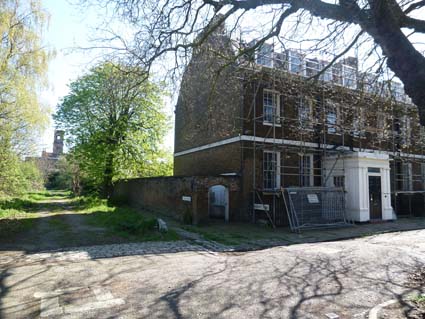Building Preservation Trust in Dramatic Rescue of Key Endangered Site
24 March 2011
The Spitalfields Historic Buildings Trust has completed the heroic rescue of one of the most important and endangered historic sites in the South East of England.
The Trust, acting as the nominee for a group of investors, and with the help of a loan from the Architectural Heritage Fund, has successfully sealed the £1.85m purchase of a complete 1820s naval officers’ residential quarter at Sheerness Dockyard. The site, on the Isle of Sheppey, Kent, contains six Grade II* and four Grade II buildings on four acres of land. It has been empty (save for one protected tenant) and on English Heritage’s national at risk register for the best part of a decade. In 2009 the entire dockyard was added to the World Monuments Fund's international Watch List of endangered historic sites.
In recent years the site has been under the shadow of redevelopment proposals involving the building of apartment blocks on the historic landscape. This application was finally refused at planning last year after a strong campaign involving local people, the national amenity societies and SAVE. Following this decision, the Trust entered into negotiations with the owner to acquire the site.
The investors - who have taken on seven of the ten available properties - will restore them as single homes. The buildings include Regency Terrace (a row of five elegant houses) and the magnificent Dockyard House, built for the Chief Superintendent of the yard and later converted to offices. The three remaining properties will be held by the Trust, to be passed on to suitable purchasers. The Trust will be responsible for submitting the necessary planning applications, will oversee the rehabilitation of the site, and will carry out the repair work to the envelope of Regency Terrace.
The Royal Naval Dockyard at Sheerness was planned and engineered by John Rennie and constructed by successive surveyors Edward Holl and George Ledwell-Taylor. It was Ledwell-Taylor who (during the 1820s and 30s) was responsible for a majority of the residential buildings - all of which were built to exacting standards, with restrained Grecian detailing. When built, Sheerness was arguably the most advanced naval installation in the world. The dockyard closed in 1960 and since then has operated as a commercial port.
William Palin, Secretary of SAVE, says ‘This is one of the greatest heritage rescues of recent years, and proof that viable conservation solutions can be found for even the most difficult historic sites. Against all the odds, the Spitalfields Trust has managed to assemble, within its expert embrace, a group of sympathetic and passionate investors who, together, will return this magnificent site to its former glory. SAVE is pleased to have had a hand in this rescue and wishes the Trust well with this exciting project.’
The Spitalfields Trust was founded in 1977 to prevent the destruction of Georgian Spitalfields in London. Since then it has taken on and repaired over 60 buildings, including a medieval manor house in Wales and Shurland Hall, a Tudor palace on the Isle of Sheppey.
Notes to Editors:
For more information about the Spitalfields Trust and the remaining Sheerness properties contact: Oliver Leigh-Wood or Tim Whittaker (administrators) on 020 7247 0971. Email









